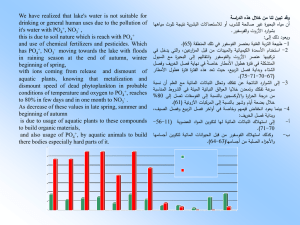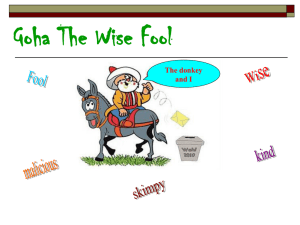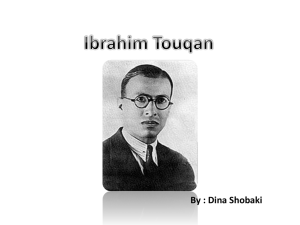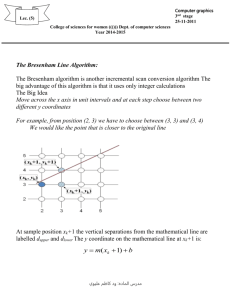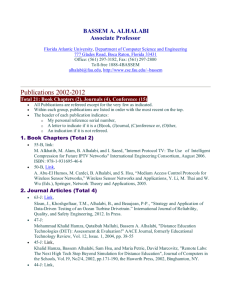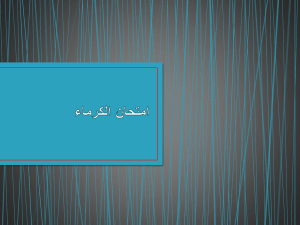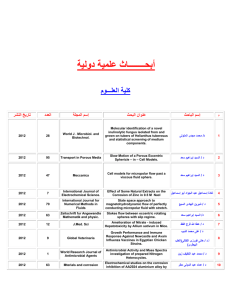مضاف إليه - Miraath Publications
advertisement
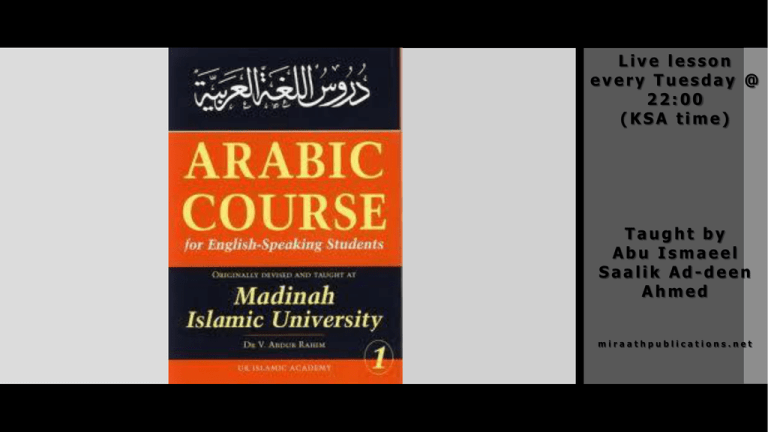
Live lesson every Tuesday @ 22:00 (KSA time) Taught by Abu Ismaeel Saalik Ad-deen Ahmed miraathpublications.net PREVIOUSLY COVERED IN LESSON 4b 1. Exercises from lesson 4a 2 . Vo c a b u l a r y f o r l e s s o n 4 b 3. Grammar for lesson 4b 1.Prepositions 2.Pronouns 1.Lesson 4b from the text book TEXT BOOK LESSON 4b أنا من اليابان ال عم ٌار من الصين ّ هو من الهند ب إلى المدير َذ َه َ علي إلى المرحاض ب ٌّ الَ ,ذ َه َ على إلى من في من إلى VOCABULARY T h e K a ’ b a h : الكعبة T h e S o n : االبن T h e M a t e r n a l U n c l e : الخال T h e C a r : السيارة ّ LESSON 5 Closed : ق ٌ َُمغل T h e r e : اك َ ُهَن T h e M e s s e n g e r : الرسول T h e N a m e : االسم T h e P a t e r n a l U n c l e : العم T h e B a g : الحقيبة T h e S t r e e t : الشارع B e n e a t h / U n d e r : حت َ َت GRAMMAR مضاف و مضاف إليه- اإلضافة The Possessive Expression اإلضافةis used to show how one noun belongs to another noun or is possessed by another noun. Example:سيارةُ المدير ّ The manager’s car سيارةُ مدير ّ A manager’s car سيارة ّ : المضاف/ The possessed المدير: المضاف إليه/ The possessor LESSON 5 The مضافalways precedes the مضاف إليه The مضافchanges it’s case ending depending on it’s function in the sentence, however, the مضاف إليهis always مجرور سيارةُ المدير ّ The manager’s car - المضاف: The Possessed Always precedes the مضاف إليه - Can be in any case (nominative - dhammah, genitive - kasrah, accusative fatthah) - By default it is definite even though it doesn’t have ‘al’ before it - It doesn’t accept the tanween. - المضاف إليه - Can be definite or indefinite - Is always in the genitive case : The Possessor Indeclinable words : كلمات مبنية In Arabic some words are indeclinable, meaning that their endings do not change regardless of their function within a sentence or what they are preceded by. These types of words in Arabic are referred to as being مبنية. Examples: كتاب َمن هذا؟ ُ = َمن أين خرج محمد؟ َ أين = من َ هذا = خرج محمد من هذا الفصل حت َ َ ت/ Beneath, under The noun that follows تحتtakes the genitive case because it is مضاف إليه Example: الحقيب ُة تحت المكتب The bag is underneath the desk همزة الوصل و همزة القطع The Arabic letter ‘ ا- Alif’ is of two types: 1 – همزة القطع- أ: Hamza tul-qat’ – This type of Hamza is always pronounced. أين ذهب محمد و أين ذهب علي 2 - همزة الوصل- ا: Hamza tul-wasl – Some words begin with this type of Hamza. If that word is preceded by a word or letter then this Hamza is not pronounced, however, it remains in written form. ابن اإلمام طبيب وابن المدير مدرس النداء: Vocative Particle In Arabic a word that is used for calling someone is called An-nidaa النداءand in Arabic we use ‘ ’ياfor this purpose. Example: a teacher : مدرس oh teacher : مدرس يا ُ - The word that follows the نداءis referred to as المنادى. - The منادىis usually in the nominative case and even if the منادىis indefinite it still only takes one vowel. LESSON 5 TEXTBOOK THANK YOU شكرن Miraathpublications.net
